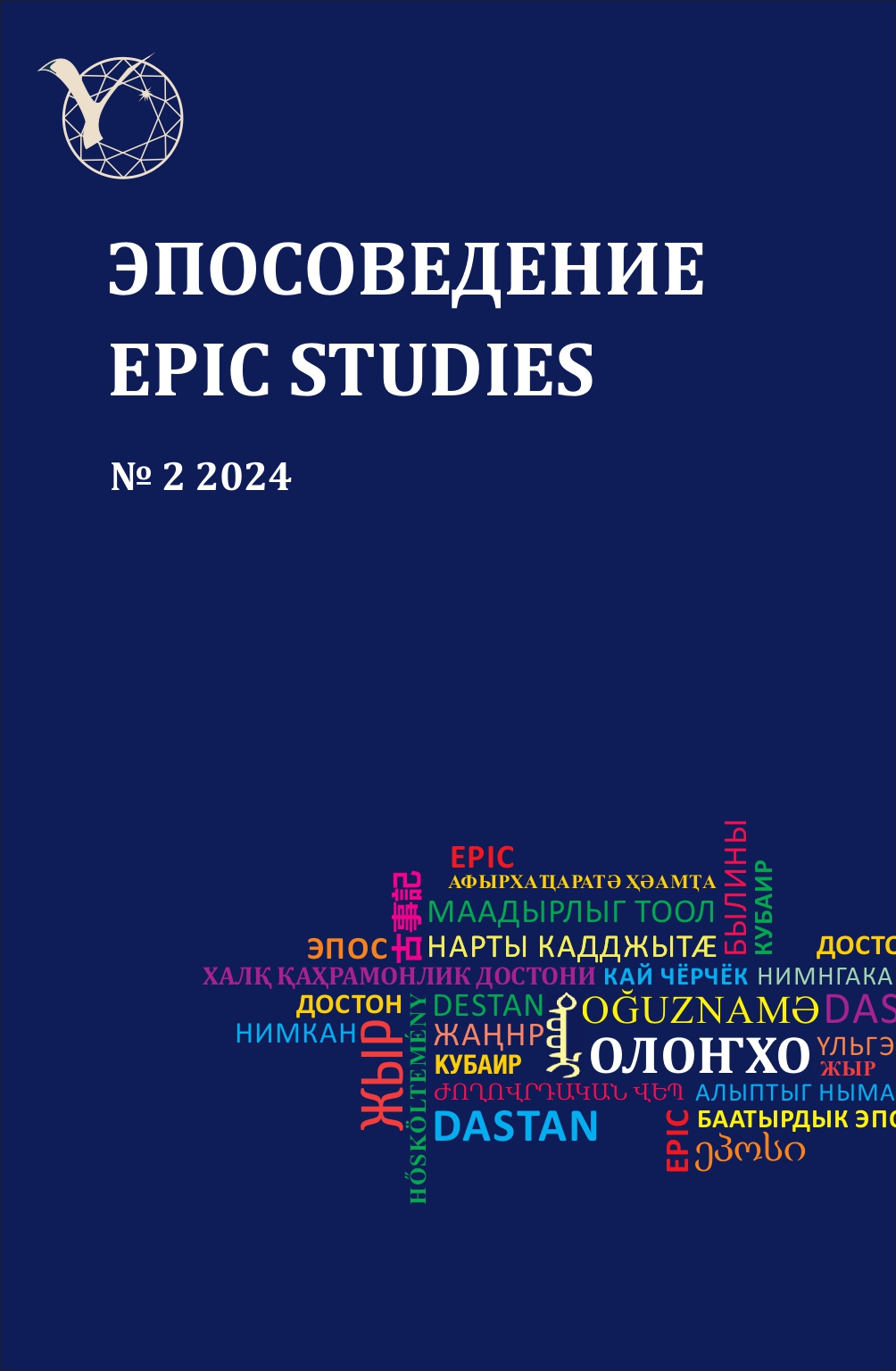THE NARRATIVE OF RICE ORIGIN IN THE CREATION EPICS: EVOLUTION OF RICE ORIGIN NARRATIVES UNDER THE INFLUENCE OF THERAVADA BUDDHISM
DOI:
https://doi.org/10.25587/2782-4861-2024-2-19-37Keywords:
Rice origin narratives; Rice soul worship; Creation Epics; Oral tradition; Theravada Buddhism; Rice god; Rice myth; Rituals; Ya Huanhao; Chinese ethnic groupsAbstract
The introduction of Theravada Buddhism has influenced the original narratives of rice origins among ethnic groups such as the Dai, De'ang, and Bulang. There are rich rice origin narratives in the creation epics from the three ethnic groups. This article aims to explore how the incoming Buddhism has enabled three distinct ethnic groups with different languages, cultures, and historical backgrounds to share some similar narratives of rice origin. Taking the ethnographic fieldwork methods, involving participant observation and individual interviews with villagers, to collect and compare both oral and written narratives for analysis, the findings reveal that they share some familiar primarily manifested in three aspects: firstly, these ethnic groups share commonalities in their rice origin narratives, incorporating numerous elements of Buddhism. Buddhism has adapted these narratives by substituting vocabulary and transforming concepts to infuse them with strong Buddhist elements. Secondly, a new type of narrative appeared, where the rice god contends with Buddha and ultimately departs to the Dark World and then be brought back by Buddha. The theme of rice god versus Buddha mirrors the historical struggle between two faiths. Meanwhile, the theme of rice god’s departure to the Dark World and return fundamentally serves as a metaphor for seed germination and growth in the soil, representing a concession made by Buddhism to the worship of the indigenous beliefs. Thirdly, Buddhism actively participates in and promotes rice cultivation, such as monks reciting the Bu Huanghao to request blessings for crop growth, and performing rituals like washing Buddha pagodas to pray for rain. In conclusion, the introduction of Buddhism has significantly influenced local rice narratives, reflecting the conflicts and eventual reconciliation between the rice god and Buddha, as well as the struggle and compromise between traditional beliefs and incoming Buddhism. Acknowledgement: This article is supported by the “Dengfeng Zhanlue” (Pinnacle Strategy) funding program for discipline development of the Chinese Academy of Social Sciences. Project Title: Chinese Epic Studies, Grant No.: DF2023YS07.
References
1. Gampi Gampa: The Creation Epic of the Dai Ethnic Group. Translated by Yue Xiaobao and Lang Meihan. Mangshi, Dehong Nationalities Publishing House, 2020, 269 p. (In Chinese and Dai Le)
2. Mangshi Intangible Cultural Heritage Protection Center. Dagudaleng Gelaibiao (Collection of Poetry and Paintings). Mangshi, Dehong Nationalities Publishing House, 2016, 359 p. (In Chinese and Dai Le)
3. Chinese Folk Songs Collection: Yunnan Volume. Compiled by the National Editorial Committee of Chinese Folk Literature Integration and the Editorial Committee. Beijing, China ISBN Center, 2003, 1840 p. (In Chinese)
4. Li Dezhu, et Hu Shaohua. Encyclopedia of Chinese Ethnicities: Volume 15 (Dai, Wa, Jingpo, Bulang, Achang, De'ang, and Ji Nuo Ethnic Groups). Beijing, World Publishing Corporation, 2016, 473 p. (In Chinese)
5. Mao Xing. Literature of Chinese Ethnic Minorities: Volume II. Changsha, Hunan People's Publishing House, 1983, 584 p. (In Chinese)
6. Yao Baoxuan. Mythologies of Various Ethnic Groups in China-Hani and Dai Ethnic Groups volume. Taiyuan, Shuhai Publishing House, 2014, 385 p. (In Chinese)
7. Folk Stories of the Dai Ethnic Group in Xishuangbanna. Editorial Group of Folk Stories of the Dai Ethnic Group in Xishuangbanna. Kunming, Yunnan People's Publishing House, 1984, 437 p. (In Chinese)
8. Hu Yuefang. The Gu Hun and Dai Ethnic Religious Beliefs. Studies of Minority Classics. Vol. 1. 2012, pp. 200–217. (In Chinese)
9. Creation Epic of the Dai Ethnic Group: Batamagga Pangshanglo. Xishuangbanna State Ethnic Affairs Commission. Kunming, Yunnan People's Publishing House, 1989, 507 p. (In Chinese)
10. Wang Guoxiang. On Rice Cultivation Rituals and Rice Mythology of the Dai and Bulang Ethnic Groups. Journal of Minzu University of China (Philosophy and Social Sciences Edition). 2000, No. 6, pp. 97–103. (In Chinese)
11. He Guangyu, He Xin. Cultural Interpretation of Southwest Ethnic Minorities' Primitive Religious Beliefs and Mythology in the Cycle of Original Wisdom. Guiyang, Guizhou People's Publishing House, 2010, 697 p. (In Chinese)
12. Hu Yuefang. Dai Texts “Gu Hun” and Dai Ethnic Religious Beliefs. In: Chinese Ethnic Ancient Texts Research Society (ed). Chinese Ethnic Ancient Texts Research: Volume 4. Tianjin, Tianjin Ancient Books Publishing House, 2012, pp. 211–218. (In Chinese)
13. Interview with Uncle Li, Qian Youliang and Beng Shaoliang. In: Materials of the field study of Dai Ethnic Folk Culture in Dehong Prefecture [Manuscript], Yunnan Province, China. 2016, p. 18. (In Chinese)
14. Interview with Xiang Xiaohuan and Chen Bowan. In: Materials of the field study of Dai Ethnic Folk Culture in Dehong Prefecture [Manuscript], Yunnan Province, China. 2016, p. 18. (In Chinese)
15. Yin Shaoting et Tang Li. Bibliography of Ancient Dai Manuscripts in Yunnan China. Kunming, Yunnan Nationalities Publishing House, 2002, 881 p. (In Chinese)
16. Qin Ying and Li Baichuan. Modern Changes in Traditional Irrigation Systems of the Dai Ethnic Group. Beijing, China Science and Technology Press, 2014, 265 p. (In Chinese)
17. Dao Guodong. Dai Le. Kunming, Yunnan Fine Arts Publishing House, 2007, 145 p. (In Chinese)
Downloads
Published
How to Cite
Issue
Section
License
Copyright (c) 2024 EPIC STUDIES

This work is licensed under a Creative Commons Attribution 4.0 International License.
Copyright (c) 2021 Copyright (c) This work is licensed under a Creative Commons Attribution 4.0 International License.












 Olonkho Research Institute, M.K. Ammosov North-Eastern Federal University
Olonkho Research Institute, M.K. Ammosov North-Eastern Federal University